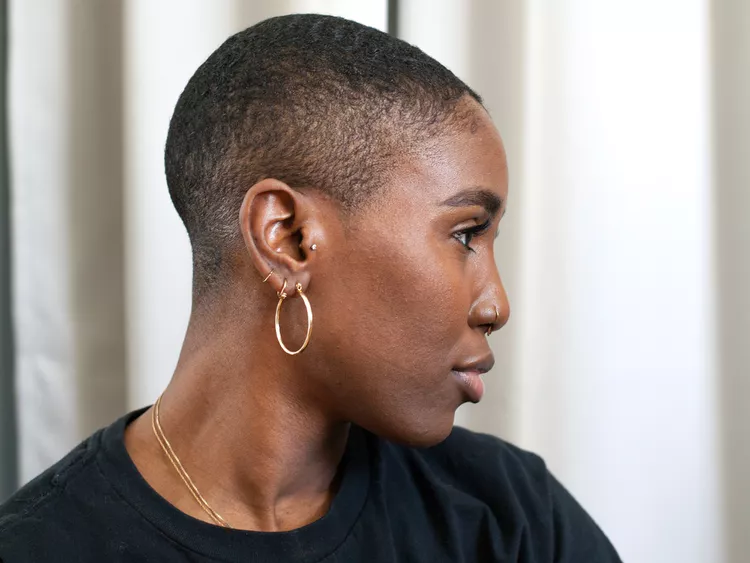
Shaving can be a pain, but dealing with ingrown hairs can be much worse. Ingrown hairs result from the hair follicle growing under the skin instead of emerging above it and can ultimately cause irritation and inflammation. While they’re typically found on your face, legs, armpits, and pubic area, ingrown hairs can develop anywhere on the body, even your scalp.
So, if an ingrown hair develops on your scalp, how should you go about getting rid of it? To find out, we turned to three board-certified dermatologists—Dr. Fatima Fahs, Dr. Marisa Garshick, and Dr. Neera Nathan—for their expert opinion. Keep reading to learn seven ways to get rid of ingrown hairs on the scalp.
01of 07Take Preventative Measures
All three of our experts stressed that the first step in treating ingrown hairs on the scalp is to try to prevent them from forming at all. Garshick says it’s important to use proper shaving techniques, including shaving in the direction of the hair growth, cleansing the skin, and wetting the hairs before shaving to make them softer. Other key preventative steps include washing your hair regularly and avoiding products that cause buildup on the scalp.
02of 07Cleanse with Salicylic Acid Shampoo
Salicylic acid is widely used in skincare products for its ability to treat acne. It has been found to reduce redness and inflammation in addition to serving as a chemical exfoliant.1 Exfoliation is your best friend when it comes to getting rid of ingrown hairs, as it will help to remove skin cells and buildup.
Salicylic acid shampoos and cleansers are an easy way to get the ingrown-fighting powers of this ingredient directly to your scalp. Garshick recommends the Drybar Crown Tonic Pre-Shampoo Scalp-Balancing Cleanser ($36), noting it helps exfoliate and eliminate excess oil, helping to maintain the overall health of the scalp.
03of 07Use a Scalp Scrub
Garshick says the key to preventing ingrown hairs is regularly washing the scalp and occasionally exfoliating to minimize buildup. Fahs and Garshick agree that exfoliants like scalp scrubs are helpful in treating existing ingrown hairs on the scalp and preventing future ones.
If you’re currently experiencing ingrown hairs on the scalp, it’s important to choose a scrub with the right ingredients. Garshick recommends the Sukin Natural Balance Scalp Scrub ($16)—which contains soothing peppermint and ginger extract—because it gently exfoliates and helps to prevent ingrowns using bamboo powder. Fahs recommends the Nioxin Scalp Recovery Purifying Exfoliator ($24) because it contains exfoliating biodegradable cellulose microbeads and a burst of cooling mint to ease the scalp and provide a clean feeling. “Use this scrub before shampooing and massage directly onto the scalp, follow with shampoo and a moisturizing conditioner,” explains Fahs.
04of 07Try a Scalp Serum
Depending on the severity of your ingrown hair, you may need to apply a leave-on product like a scalp serum. Nathan recommends looking for products containing zinc, which can soothe irritation. Serums that reduce inflammation and help gently remove skin cells around the blocked hair follicle (exfoliate) can help to release the trapped hair, explains Nathan. She recommends Vegamour’s GRO Scalp Detoxifying Serum ($64), which contains zinc and hydrating ingredients to prevent further buildup-causing flakes.
Garshick recommends using scalp serums with salicylic acid, like the First Aid Beauty Anti-Dandruff Scalp Serum ($32). “While marketed for dandruff, this salicylic acid serum can also help with ingrown hairs as the salicylic acid helps to exfoliate to prevent clogged pores and buildup,” she notes.
05of 07Stop Wearing Hats
You may be inclined to cover your scalp with a hat if an ingrown hair develops there, but it could make things worse. Nathan explains that friction and occlusion from tight hats or helmets may contribute to ingrown hairs by preventing the hair from emerging from the skin.
If you are already suffering from ingrown hairs on the scalp, wearing a hat can cause uncomfortable friction on the inflamed area, cause additional ingrown hairs, and trap oils against the scalp, which exacerbates buildup.
06of 07Avoid Scratching or Picking at Your Scalp
The temptation to pick at ingrown hairs is strong, but Nathan advises against doing so. “If you do get ingrown hairs on the scalp, avoid picking them as this can lead to more inflammation and possible scarring or hair loss,” cautions Nathan.
07of 07Visit a Dermatologist for Prescription-Strength Treatment
When is an ingrown hair on the scalp worthy of a dermatologist visit? Fahs says if you see pus or discolored fluid, it’s best to have your scalp evaluated by a dermatologist, as you may need topical or oral antibiotics to treat a hair follicle infection called “folliculitis.”
Dermatologists also have other tools available that may help get rid of the swelling faster, which is important when it’s in a noticeable location like the scalp. For example, Garshick shares that, in some cases, they can administer cortisone injections to treat the problem quickly.
FAQWhat causes ingrown hairs on the scalp?
Like anywhere else on the body, ingrown hairs are caused by hair follicles growing under the skin rather than above it. Certain activities like shaving your head or having scalp buildup can make you more likely to experience ingrown hairs on the scalp.
What gets rid of ingrown hairs on the scalp?
There are many treatment options available for ingrown hairs on the scalp, such as salicylic acid shampoos, scalp scrubs, and serums.
When does an ingrown hair on the scalp require medical treatment?If you notice pus or fluid, it’s best to have your scalp evaluated by a dermatologist, as you may need topical or oral antibiotics to treat a hair follicle infection.